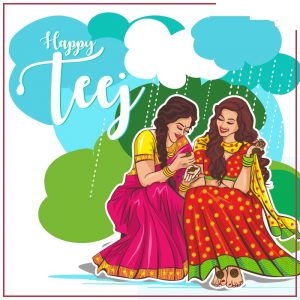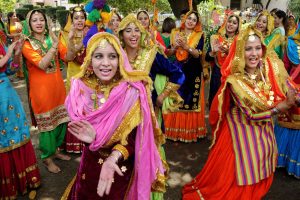A festivity celebrated in various parts of India for several ideologies attached to it and is known as ‘Teej’. The word ‘Teej’ in Hindi refers to the ‘third day’ after the new moon and the full moon.

In the monsoon season as per the Hindu methodology, it is celebrated thrice, as on the third day of the waxing moon in the month of Shravan(Hindu month), the third day of the waning and waxing moon in the month of Bhadrapada(Hindu month) and namely known as Haryali(green) Teej, Kajari/Kajli Teej and Hartalika Teej respectively.

Note: Hariyali Teej falls on August 3, 2019; Kajri Teej on August 18, 2019, and Hartalika Teej on September 1, 2019.
Kajli Teej is celebrated three days after Raksha Bandhan and five days before Janam Ashtami. The festival of Kajli Teej falls between Krishna Paksha and Bhadrapada month in North Indian calendar.
Teej festival is celebrated with joy and zeal in the Northern as well as the Western parts of India. Among all the three Teejs, Haryali Teej is widely celebrated in various states of Northern, Western, and North-Western states in India with the most renowned and grandest manner. However, Kajari/Kajli Teej and Hartalika Teej are celebrated at the regional level.
The parents of newly married girls invite them back to celebrate the festival. The married girls get Sindhara from their in-laws which include clothes, mehndi, ornaments, make-up, sweets, and many more things. The girls who are engaged receive gifts from their in-laws on this day. Married girls get gifts from their parents and those gifts are passed on to their mothers-in-law after worshipping.

Apart from this, there is a mythological persuasion being associated with it Goddess Parvati and Lord Shiva. As per the Hindu texts, after the immolation of Sati, Lord Shiva’s first wife in protest of her father’s denunciation for Lord Shiva, she incarnated as Parvati. The grief-stricken Shiva went into meditation stage and it took 108 subsequent births by Goddess Parvati to take him out of that stage and accept her as his wife. This is the reason that it is celebrated as a festival for the union of Shiva and Parvati. It is said that the married girls fast for the long life of their husbands and continue their marital bliss. Even unmarried girls fast on this day to seek blessings for an eligible match in the future.

There are various ways to celebrate it among the communal, especially, the married women and young girls. They apply henna on their hands and wear colourful bangles and matching clothes. In many places, females of a locality get together, sing songs, dance and also paly on swings.
In Punjab, Teej is associated with greenery and prosperity. It is widely celebrated at colleges and schools. Students dress in traditional clothes, participate in various performances, beauty pageant contests. The girls and married women also apply henna on their hands, sing, dance and enjoy the day dedicated to their fiancées and husbands. Teej in Punjab is known for the attire the girls wear during the festivity along with giddha performance. Usually fair is organized in the villages and towns to celebrate the day.

It is undeniable that India is a land of festivals and Teej is a festival celebrated during monsoon which is celebrated by females of all cultures. There is much to witness and enjoy Teej in India.
This is our cultural heritage that I can fetch and jot down to disseminate, however, if you wish to add more, do comment, share your pictures, and let us know the importance of the day in the comment section below.

